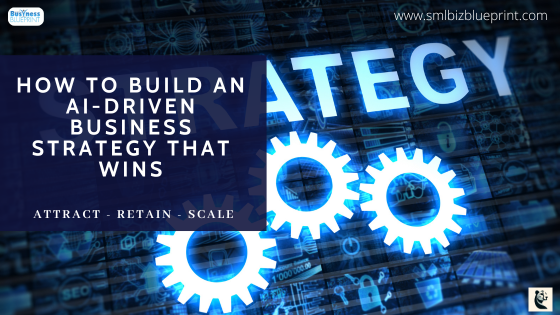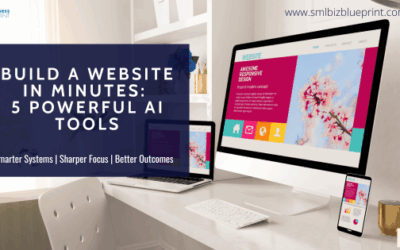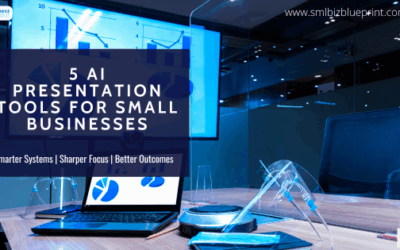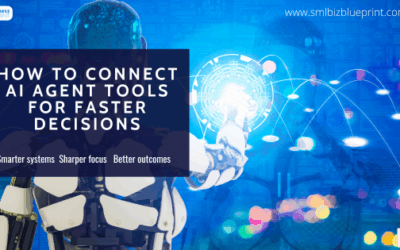The business landscape is evolving faster than ever, and companies that fail to adapt risk being left behind. Artificial intelligence (AI) is no longer a futuristic concept—it’s a game-changing tool transforming industries.
From automating tasks to enhancing decision-making, AI is reshaping the way businesses operate, compete, and grow.
Yet, many business owners and executives struggle to integrate AI into their long-term strategy.
Questions like “Where do I start?”, “How do I know if my business is ready for AI?”, and “What’s the ROI of AI implementation?” often hold businesses back from taking the leap.
Without a clear roadmap, AI adoption can feel overwhelming and uncertain.
But here’s the reality: Businesses that successfully implement AI are seeing tangible results. According to a McKinsey & Company report, companies that embed AI into their strategy experience a 20-30% increase in efficiency and a 5-10% revenue boost.
Whether you run a small business or a multinational corporation, leveraging AI strategically can help you gain a competitive edge, streamline operations, and future-proof your business.
This guide will break down:
- What an AI-driven business strategy is and why it matters
- How to assess if your business is ready for AI implementation
- Step-by-step instructions for integrating AI into your operations
- Best practices for measuring AI success and scaling for the future
- Key considerations around AI ethics, compliance, and security
By the end of this post, you’ll have a clear, actionable plan to start leveraging AI the right way—ensuring sustainable growth and success in an increasingly digital world.
Let’s dive in.

#1 What Is an AI-Driven Business Strategy?
Understanding AI in Business Strategy
An AI-driven business strategy integrates artificial intelligence into a company’s long-term planning, decision-making, and operations to enhance efficiency, scalability, and innovation.
Unlike traditional business strategies that rely on historical data and intuition, AI-powered strategies leverage real-time data, predictive analytics, and machine learning algorithms to drive smarter, faster decisions.
Companies that implement AI strategically can:
✅ Optimize workflows by automating repetitive tasks.
✅ Enhance decision-making with data-driven insights.
✅ Improve customer experiences through personalisation and automation.
✅ Reduce costs by streamlining operations and minimising waste.
✅ Adapt to market shifts faster than competitors.
How AI Differs from Traditional Business Strategy
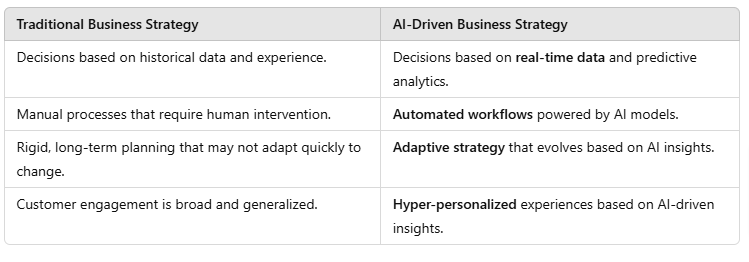
Why AI-Driven Strategy Matters: Real-World Examples
Businesses across industries are already leveraging AI to gain a competitive edge. Here are a few standout examples:
Netflix: AI-Driven Personalization & Content Recommendations
AI Usage: Netflix’s recommendation engine analyses user behaviour, watch history, and preferences to suggest content.
Impact: 80% of content watched on Netflix comes from AI-driven recommendations, increasing engagement and retention.
Amazon: AI-Powered Demand Forecasting
AI Usage: Amazon leverages AI and machine learning to predict inventory demand, reducing supply chain inefficiencies.
Impact: This results in faster deliveries, lower storage costs, and improved customer satisfaction.
Sephora: AI-Enhanced Customer Engagement
AI Usage: Sephora’s AI-driven chatbots and virtual try-on technology allow customers to receive tailored beauty recommendations.
Impact: Online sales increased by 11%, and customer engagement improved significantly.
How to Start Thinking About AI in Your Business Strategy
AI isn’t just for tech giants—it’s accessible to businesses of all sizes. Whether you’re in e-commerce, finance, healthcare, or real estate, AI can enhance operations, decision-making, and customer engagement.
Tips
1️⃣ Identify AI-Ready Areas in Your Business:
Look for repetitive, time-consuming tasks AI can automate (e.g., customer service, marketing, inventory management).
Example: A real estate firm can use AI-powered market analysis tools to predict property trends and optimise pricing strategies.
2️⃣ Start Small & Test AI Solutions:
Before committing to large-scale adoption, begin with AI-powered tools like chatbots, AI analytics, or marketing automation software.
Example: A small retail store can use AI-driven email marketing automation to personalize promotions based on past customer purchases.
3️⃣ Invest in AI Education & Training for Your Team:
AI adoption requires a culture shift and skill development. Offer training programs to help employees understand and work alongside AI tools.
Example: Implementing AI in customer service? Train your team on how to use AI chatbots while maintaining a human touch for complex inquiries.
By understanding an AI-driven strategy and how it can be applied, businesses can take the first step toward long-term success in a data-driven world.
Now that you understand what an AI-driven business strategy entails, the next step is to evaluate whether your business is ready for AI adoption.
#2 Why Your Business Needs AI for Long-Term Success
AI Is No Longer Optional—It’s a Competitive Advantage
The business world is shifting rapidly, and companies that fail to adopt AI risk falling behind competitors who leverage data-driven insights, automation, and intelligent decision-making.
AI is no longer just an add-on for tech companies—it’s becoming a core driver of business growth, efficiency, and long-term sustainability across industries.
According to PwC, AI is projected to contribute $15.7 trillion to the global economy by 2030, with businesses experiencing:
- Increased efficiency through process automation.
- Enhanced customer experiences with AI-driven personalisation.
- Stronger decision-making capabilities backed by real-time data.
- Higher revenue growth by optimising sales, marketing, and operations.
How AI Gives Your Business a Competitive Edge

Industries Already Benefiting from AI
AI transforms industries by enhancing productivity, improving customer engagement, and optimising business processes.
Let’s look at how AI is reshaping different sectors:
Retail: AI-Driven Personalization & Inventory Management
AI Usage: Brands like Nike and H&M use AI to analyse shopping behaviour, forecast trends, and personalised recommendations.
Impact: AI-powered inventory systems reduce overstock by 20%, cutting costs and improving sales.
Healthcare: AI-Powered Diagnostics & Patient Care
AI Usage: IBM Watson Health and AI-driven imaging tools help doctors detect diseases earlier and recommend personalised treatments.
Impact: AI-powered diagnostics reduce diagnostic errors by up to 50%, improving patient outcomes and efficiency.
Finance: AI for Fraud Detection & Automated Trading
AI Usage: JPMorgan and PayPal use AI to detect fraudulent transactions in real-time, preventing financial losses.
Impact: AI-driven fraud detection reduces false positives by 80%, increasing transaction security.
Marketing: AI-Powered Customer Insights & Campaign Optimization
AI Usage: Coca-Cola and Spotify use AI to analyse consumer behaviour and optimise marketing campaigns for maximum engagement.
Impact: AI-driven marketing increases conversion rates by up to 30% by targeting the right audience with personalised content.
Why AI Adoption Is Essential for Business Growth
Companies that fail to implement AI risk inefficiencies lost revenue opportunities, and declining market relevance.
Here’s why AI adoption is crucial for businesses of all sizes:
Improved Efficiency & Cost Savings
AI automates time-consuming manual processes, allowing teams to focus on strategic tasks.
AI-powered chatbots reduce customer service workload by 60%, enabling businesses to provide faster support with fewer resources.
Stronger Decision-Making & Market Adaptability
AI analyses real-time market trends and customer data, enabling businesses to predict demand, optimise pricing, and make smarter investment decisions.
Example: AI-driven predictive analytics helped Walmart optimise inventory, reducing supply chain costs by 15%.
Enhanced Customer Experience & Retention
AI personalises customer interactions based on past behaviour, increasing satisfaction and retention rates.
Example: Starbucks’ AI-powered loyalty program boosts customer engagement by 40% through customised promotions.
Tips
- Identify AI Tools That Fit Your Business Needs
For marketing: Use AI-driven tools like HubSpot or Jasper AI for content creation and automation.
For customer service: Implement AI chatbots (e.g., Drift, ChatGPT) to handle FAQs and improve response times.
For sales & analytics: Use AI-powered CRM systems like Salesforce Einstein for data-driven decision-making. - Start with Small-Scale AI Implementations
Test AI in one area of your business first (e.g., customer support or marketing automation).
Example: A small e-commerce store could use AI-powered product recommendations before expanding AI adoption to logistics. - Invest in AI Education for Your Team
Upskill employees with AI training programs to ensure a smooth transition.
Example: Companies that train employees on AI tools see 20-30% faster AI adoption rates and higher productivity.
The businesses that thrive in the coming years will embrace AI as a core strategy rather than an afterthought. AI enables companies to operate more efficiently, understand customers better, and scale without proportionally increasing costs.
Ready to level up your business?
Sign up for our newsletter and get expert tips delivered weekly.
#3 How to Assess Your Business’s AI Readiness
Is Your Business Ready for AI?
AI adoption is a game-changer, but not every business is ready to integrate AI immediately. Before jumping into AI-driven solutions, companies must assess their data infrastructure, technology stack, workforce readiness, and strategic goals.
According to Deloitte’s AI Readiness Report, 70% of businesses struggle with poor data quality before AI adoption, which leads to ineffective implementation, wasted resources, and missed opportunities.
A structured AI readiness assessment helps businesses avoid costly mistakes and ensures that AI is deployed for maximum impact.
Key Factors to Evaluate Before Implementing AI
To determine whether your business is AI-ready, focus on the four essential pillars of AI adoption:
Data Readiness: Do You Have the Right Data for AI?
AI thrives on high-quality, structured data. Without accurate and relevant data, AI models cannot generate reliable insights.
✅ Assess Your Current Data Sources:
Where does your business collect data from? (CRM, website analytics, customer interactions, sales records, etc.)
Is your data structured (clean, categorised) or unstructured (scattered across multiple platforms)?
✅ Ensure Data Accuracy & Security:
AI models require consistent, unbiased, and high-quality datasets to perform effectively.
Businesses must comply with data privacy regulations (e.g., GDPR, CCPA) to ensure ethical AI use.
📌 Example: A retail company looking to use AI for customer purchase predictions must first ensure its transactional and behavioural data is clean, updated, and properly stored in an integrated system.
Technology Readiness: Can Your Systems Support AI?
Your business must have a solid tech infrastructure to integrate AI seamlessly.
✅ Evaluate Your Current Tech Stack:
Does your company use cloud-based systems for scalability?
Can you access AI-friendly tools (e.g., CRM with AI capabilities and AI-powered analytics software)?
Can your IT infrastructure handle data processing and AI computing needs?
📌 Example: A financial services firm using outdated legacy systems might need to migrate to cloud platforms before implementing AI-powered fraud detection.
Workforce Readiness: Does Your Team Have AI Knowledge?
AI is only as good as the people who use it. Businesses need a workforce that understands AI tools and how to leverage them.
✅ Assess AI Awareness & Skills:
Do employees understand how AI can improve their workflow?
Does your company offer AI training programs or workshops?
Do you have the right AI talent (e.g., data scientists, AI consultants, AI-powered marketing specialists)?
📌 Example: A marketing agency introducing AI-powered ad automation must train its team on how to interpret AI-driven insights for better campaign performance.
Business Strategy Readiness: Do You Have Clear AI Goals?
AI should align with your long-term business objectives. Companies must define:
✅ AI’s Role in Business Growth:
What problems will AI solve? (e.g., improving customer service, automating manual tasks, enhancing decision-making)
How will AI increase efficiency, reduce costs, or drive revenue?
📌 Example: A real estate firm looking to use AI should define whether it will be used for property price predictions, customer chatbots, or lead generation optimisation.
How to Perform an AI Readiness Audit (Step-by-Step Guide)
Step 1: Audit Your Data
Identify where your data comes from and assess its accuracy and completeness.
Check if data storage meets AI compliance and security requirements.
Step 2: Review Your Technology Stack
List all existing software and tools to determine compatibility with AI integration.
If necessary, upgrade cloud infrastructure or data storage solutions.
Step 3: Conduct an AI Skills Gap Analysis
Identify employees who need AI training or upskilling.
Consider hiring AI specialists or outsourcing AI implementation to an AI consultancy.
Step 4: Define AI Objectives & ROI Expectations
Set clear, measurable AI goals (e.g., “Automate 50% of customer inquiries within six months”).
Outline expected ROI metrics (e.g., cost savings, improved efficiency, customer retention rates).
Tips
- Start with Small AI Experiments Before Full Integration
Instead of overhauling entire business processes, implement AI in one area first (e.g., automated email marketing, AI-powered customer service chatbots).
Example: A retail business can start with AI-driven personalised recommendations before expanding AI to inventory management. - Invest in AI Training for Key Employees
Offer AI workshops, online courses, or AI boot camps to upskill employees.
Encourage leadership to attend AI strategy events to stay informed. - Ensure AI Aligns with Business Goals, Not Just Trends
Avoid AI adoption just for the sake of using AI.
Example: A logistics company should implement AI for real-time fleet tracking only if it aligns with long-term efficiency goals.
Before integrating AI into your business, conducting an AI readiness assessment ensures that your company has the right data, technology, workforce, and strategy in place.
#4 Step-by-Step Guide to Implementing AI in Your Business Strategy
Why AI Implementation Needs a Clear Roadmap
Adopting AI can be overwhelming without a structured approach. Many businesses fail to see ROI from AI investments because they jump in without clear objectives, proper tools, or a well-thought-out plan.
A successful AI implementation strategy focuses on solving real business problems, leveraging the right technologies, and gradually scaling AI adoption.
According to McKinsey & Company, businesses that take a structured approach to AI adoption achieve 20-30% operational efficiency gains and see faster revenue growth than companies that implement AI without a roadmap.
This section will provide a step-by-step guide to correctly implementing AI in your business.
Step 1: Define Clear AI Objectives
Before investing in AI tools, identify what AI should accomplish for your business. Ask yourself:
What specific problem are you trying to solve? (e.g., reducing manual workload, improving customer service, increasing sales)
What key business processes can be optimised using AI? (e.g., marketing automation, predictive analytics, customer support)
What ROI do you expect? (e.g., cost savings, efficiency gains, improved customer retention)
📌 Example: A retail business looking to improve customer engagement might set an AI goal to increase personalised product recommendations and boost conversions by 15% in six months.
Step 2: Choose the Right AI Technologies for Your Business
Different AI tools cater to different business needs. Selecting the right technology ensures AI aligns with your business objectives and operational capabilities.
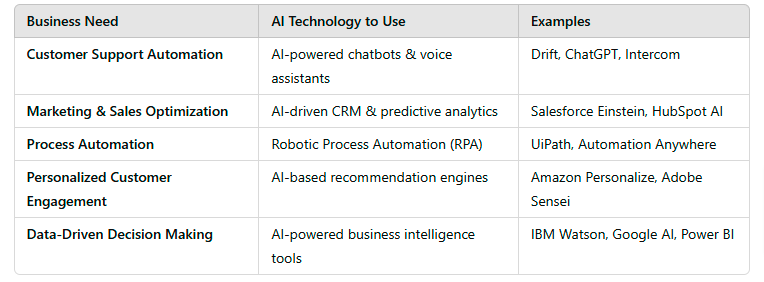
📌 Example: A B2B company wanting to automate repetitive customer service inquiries should consider AI chatbots rather than investing in predictive analytics.
Step 3: Start Small and Scale Gradually
Many businesses fail with AI because they try to integrate too many AI solutions at once. Instead, start small by introducing AI into one area of your business before scaling.
How to Implement AI in Phases:
1️⃣ Pilot Project: Start with a small AI project (e.g., an AI chatbot for FAQs).
2️⃣ Analyze Results: Measure impact on productivity, customer engagement, or cost savings.
3️⃣ Expand AI Integration: Once proven successful, expand AI to other business functions.
📌 Example: A law firm implementing AI for contract review automation should first test AI on low-risk, repetitive contracts before using it for high-value client agreements.
Step 4: Train Your Team to Work with AI
AI is only as effective as the people who use it. Many AI projects fail because employees don’t understand how to leverage AI tools effectively.
✅ Provide AI Training & Upskilling
Offer AI education programs or workshops for employees.
Ensure staff understands how to interact with AI-powered tools.
Encourage leadership teams to stay updated on AI advancements.
📌 Example: A marketing agency introducing AI-powered ad optimisation tools should train employees on how to analyse AI-driven insights to improve ad targeting.
Step 5: Measure AI Performance & Optimize for Growth
Companies must track performance and continuously improve AI models to ensure AI delivers tangible business value.
✅ Key AI Metrics to Track:
Cost Savings: Has AI reduced operational expenses?
Efficiency Gains: Has AI improved task completion speed?
Customer Satisfaction: Has AI-driven personalisation increased retention rates?
Revenue Growth: Has AI-driven marketing improved conversions?
📌 Example: A SaaS business using AI for customer support automation should track ticket resolution times, and customer satisfaction scores to measure AI effectiveness.
Tips
- Test Before Full Integration:
Before committing fully, run a pilot AI project in one department.
Example: An e-commerce store tests AI-powered pricing optimisation before expanding AI to inventory management. - Regularly Evaluate & Improve AI Performance:
AI requires ongoing monitoring and fine-tuning to stay effective.
Conduct quarterly AI reviews to optimise strategies. - Ensure AI Aligns with Business Goals:
Avoid AI adoption just for the sake of using AI—make sure it directly supports your business objectives.
Successfully implementing AI requires a well-defined roadmap, the right technology choices, gradual integration, employee training, and continuous monitoring.

#5 Optimizing AI for Business Growth and Efficiency
Why AI Optimization Matters
Implementing AI is only the first step—optimising AI for continuous growth and efficiency is where real success happens.
AI can transform businesses, but without proper refinement, monitoring, and adaptation, it won’t reach its full potential.
According to Gartner, companies that continuously optimise AI models experience 30% higher productivity gains and 25% cost savings compared to businesses that use AI without strategic refinement.
This section will explore how to fine-tune AI tools for maximum business impact, helping you streamline operations, make smarter decisions, and enhance customer engagement.
Using AI for Smarter Decision-Making
AI isn’t just about automation—it’s a powerful decision-making tool that helps businesses analyse vast amounts of data and generate actionable insights.
How AI Enhances Business Decisions:
✅ Predictive Analytics: AI can forecast trends, customer behaviours, and market demand.
✅ Real-Time Insights: AI analyses data instantly, allowing businesses to react quickly to opportunities or risks.
✅ Data-Driven Strategy Adjustments: AI refines business strategies by identifying patterns in customer behaviour, sales trends, and operational inefficiencies.
📌 Example:
Using AI-powered route optimisation, a logistics company reduced fuel costs by 20% and improved delivery times.
Automating Workflows to Increase Efficiency
AI’s most significant advantage is its ability to automate repetitive and time-consuming tasks, freeing up employees for higher-value work.
Key Areas Where AI Boosts Efficiency:
🔹 Customer Support: AI chatbots handle FAQs, reducing human workload by 60%.
🔹 Data Processing: AI speeds up invoice management, payroll processing, and document classification.
🔹 Marketing Automation: AI personalises email campaigns and optimises ad targeting in real time.
📌 Example:
A financial services firm automated its document verification process, reducing approval times from 3 days to a few hours.
Enhancing Customer Experience with AI
AI-driven personalisation is key to improving customer satisfaction, loyalty, and retention. AI can analyse customer preferences, predict needs, and deliver tailored experiences that drive engagement.
AI Strategies for Customer Experience Optimization:
✅ AI-Powered Chatbots & Virtual Assistants: Provide instant, personalised responses 24/7.
✅ AI-Driven Product Recommendations: E-commerce platforms use AI to suggest products based on user behaviour.
✅ Sentiment Analysis: AI evaluates customer feedback to improve service quality.
📌 Example:
Spotify’s AI recommendation engine increased user engagement by 30%, keeping listeners on the platform longer.
Measuring AI Performance & Continuous Improvement
AI is not a “set-it-and-forget-it” tool—it needs ongoing evaluation and refinement to deliver long-term value.
Best Practices for AI Performance Monitoring:
🔹 Track Key Performance Indicators (KPIs): Measure efficiency gains, cost savings, and customer engagement rates.
🔹 Regular AI Audits: Conduct quarterly AI reviews to identify weaknesses and optimise algorithms.
🔹 User Feedback Integration: Use customer and employee feedback to refine AI-driven interactions.
📌 Example:
A travel booking company used AI to optimise search recommendations and increased booking conversions by 18% after fine-tuning its model based on user behaviour.
Tips
- Continuously Train AI Models
AI learns over time, but datasets must be updated to maintain accuracy.
Example: A retail company should refresh its AI-powered pricing models regularly to reflect changing demand. - Monitor AI Ethics & Compliance
AI should be free of bias and aligned with data privacy laws (e.g., GDPR, CCPA).
Example: A financial services company must ensure AI-driven loan approvals comply with fair lending laws. - Leverage AI Insights to Improve Business Strategy
Use AI-generated insights to refine marketing, sales, and customer service strategies.
Example: An AI-powered CRM system can identify high-value customers, allowing businesses to prioritise retention strategies.
AI is a powerful tool for business growth, but only when continuously optimised and aligned with evolving business needs. Companies can unlock sustained efficiency and competitive advantage by refining AI models, tracking performance, and integrating AI-driven insights.
#6 Measuring the Success of Your AI-Driven Strategy
Why Measuring AI Success Is Essential
Implementing AI is a significant investment, but how do you know if it’s working? Many businesses adopt AI without transparent performance tracking, leading to wasted resources and unoptimised solutions.
Without measurement, it’s impossible to determine whether AI drives efficiency, increases revenue, or improves customer experiences.
According to a PwC AI Impact Study, businesses that actively measure AI effectiveness experience a 35% higher return on investment (ROI) and 25% better efficiency gains than those that do not.
This section outlines key performance indicators (KPIs), best practices, and real-world examples to help businesses measure and refine their AI-driven strategies.
Key Performance Indicators (KPIs) for AI Success
Businesses must track relevant metrics that are aligned with their business objectives to assess AI effectiveness.
Common AI KPIs to Measure Success
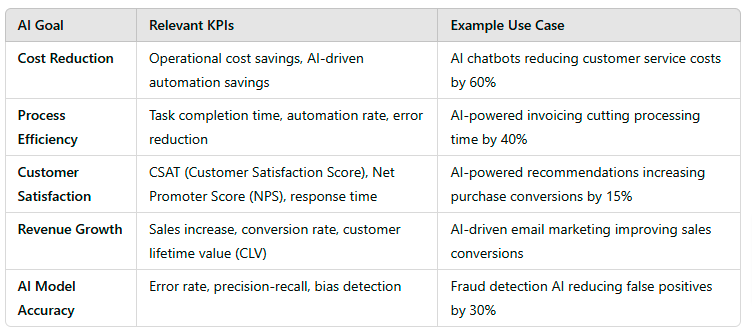
📌 Example: A financial services firm using AI for fraud detection should measure accuracy rate, false positive rate, and fraud prevention savings to assess AI performance.
Tracking AI Performance: Tools & Best Practices
Businesses should use AI monitoring tools and frameworks to analyse AI’s impact over time.
Best Practices for AI Performance Tracking
✅ Define Success Metrics Early – Before launching AI, establish measurable goals and baseline performance levels.
✅ Use AI Analytics Platforms – Leverage tools like Google AI Hub, IBM Watson AI, or DataRobot to track AI-driven insights.
✅ Monitor AI Decision-Making – Regularly audit AI decisions to detect biases, inefficiencies, or inaccurate predictions.
📌 Example: A healthcare provider using AI for patient diagnosis recommendations should conduct quarterly audits to validate AI-generated treatment suggestions.
Continuous Improvement: Refining AI for Better Results
AI is not a set-and-forget solution—it requires continuous improvement to stay effective.
How to Optimize AI Performance Over Time:
🔹 Retrain AI Models: Regularly update AI with new data to improve accuracy.
🔹 Monitor AI Bias & Ethics: Ensure AI decisions remain fair, transparent, and compliant with regulations.
🔹 Leverage AI Insights for Strategy Adjustments: Use AI-generated trend predictions to refine business goals and processes.
📌 Example: A retail company using AI for demand forecasting should adjust its AI models seasonally based on changing consumer behaviour.
Tips
- Compare AI-Driven Metrics to Pre-AI Benchmarks
Assess if AI has improved efficiency, revenue, or customer satisfaction compared to previous methods.
Example: Compare AI-driven customer support resolution times to support performance before AI adoption human-only. - Establish an AI Performance Review Cycle
Set up monthly or quarterly AI audits to track progress and make improvements.
Example: A company using AI for predictive maintenance in manufacturing should review failure predictions and cost savings every quarter. - Use A/B Testing to Refine AI Models
Test AI-generated decisions against human-controlled results to fine-tune performance.
Example: An AI-powered pricing optimisation tool should be tested against manual pricing strategies to measure impact.
Measuring AI success is crucial for long-term AI strategy optimisation. Businesses can ensure maximum ROI and sustained efficiency improvements by tracking key KPIs, using AI monitoring tools, and continuously refining AI models.
Hungry for more insights?
Subscribe to Pulse and get cutting-edge marketing and business strategies delivered right to your inbox!
Subscribe to Pulse Now
#7 Scaling and Future-Proofing Your AI Strategy
Why Scaling AI Matters
Successfully implementing AI is a significant achievement, but businesses unlock long-term competitive advantages by scaling AI and making it future-proof.
Many companies struggle to move beyond initial AI adoption, with only 20% of businesses successfully scaling AI beyond pilot projects, according to a McKinsey & Company AI Report.
AI implementation can become stagnant, inefficient, or obsolete without a clear scaling strategy.
To ensure AI continues driving business growth, companies must integrate AI across departments, update AI models regularly, and adapt to emerging AI trends.
This section outlines how businesses can effectively scale AI and ensure it remains a valuable asset in the future.
Expanding AI Integration Across Business Functions
Many businesses start with AI in one department (e.g., marketing automation or customer service chatbots). To maximise AI’s impact, companies should expand AI into multiple areas.
AI Expansion Roadmap for Business Growth
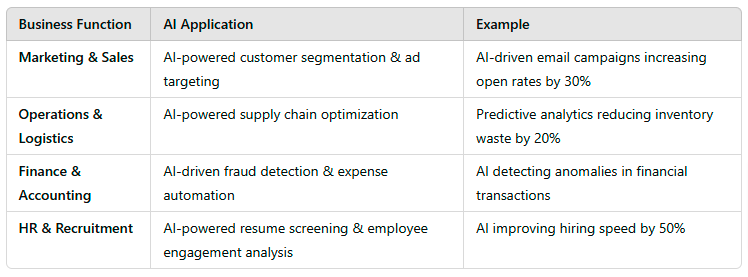
📌 Example:
A retail company using AI for personalised product recommendations can expand AI usage to predictive demand forecasting and automated pricing strategies to optimise sales.
Keeping AI Models Updated & Adaptive
AI models become outdated if they aren’t continuously trained with fresh data.
Scaling AI effectively means ensuring that AI systems learn, adapt, and evolve with business needs and market changes.
Best Practices for AI Model Maintenance:
✅ Regular AI Model Retraining: Update AI algorithms with new datasets to improve accuracy.
✅ Monitoring AI for Errors & Bias: Conduct routine AI audits to prevent inaccurate predictions or biased results.
✅ Using AI for Self-Optimization: Implement AI that adjusts itself in real time based on new data.
📌 Example:
A financial institution using AI for credit risk assessment should continuously train its AI models on new financial trends and economic shifts to improve loan approval accuracy.
Adapting to Emerging AI Trends & Innovations
AI is evolving rapidly—businesses that fail to keep up with emerging trends risk becoming outdated.
Key AI Trends to Watch:
🔹 Generative AI & Custom AI Agents: AI-powered content creation and chatbot automation.
🔹 AI for Predictive & Prescriptive Analytics: AI-powered decision-making tools improving forecasting accuracy.
🔹 AI Ethics & Regulations: Companies must align AI with data privacy laws (GDPR, CCPA) and responsible AI practices.
📌 Example:
A real estate company adopting AI for property value predictions should explore AI-powered virtual property tours and chatbots for lead generation as the next steps.
Tips
- Develop a Company-Wide AI Adoption Plan
Integrate AI into multiple business functions to maximise ROI.
Example: A company using AI for marketing automation should extend AI into customer service & sales forecasting. - Invest in AI Talent & Continuous Learning
Train employees on AI applications, ethics, and emerging trends.
Example: A logistics company implementing AI should upskill employees in AI-powered route optimisation. - Partner with AI Experts & Vendors for Scalability
Work with AI consultants or technology providers to expand AI adoption efficiently.
Example: A manufacturing firm scaling AI in production should collaborate with AI automation providers.
Scaling AI is about expanding its impact, continuously improving AI models, and staying ahead of emerging innovations.
Businesses that successfully future-proof their AI strategies will gain long-term efficiency, cost savings, and market leadership.
#8 AI Ethics, Compliance, and Security: What You Need to Know
Why AI Ethics and Security Matter
AI is revolutionising business operations, but with great power comes great responsibility.
AI can introduce bias, security risks, and compliance issues without proper safeguards that may damage a company’s reputation or lead to legal consequences.
According to a PwC AI Ethics Report, 85% of consumers believe businesses should be accountable for AI decisions, and 40% of AI projects fail due to compliance issues.
Ensuring AI ethics, transparency, and security is essential for building trust and maintaining regulatory compliance.
This section covers best practices for responsible AI use, data protection, and compliance strategies to help businesses avoid pitfalls.
Addressing AI Bias & Fairness in Decision-Making
AI models learn from data, but if that data contains biases, AI may amplify discrimination in hiring, lending, or customer service decisions.
How to Prevent AI Bias:
✅ Use Diverse Training Data – Ensure AI models are trained on representative, unbiased datasets.
✅ Regularly Audit AI Decisions – Implement AI fairness tests to detect discriminatory patterns.
✅ Make AI Decision-Making Transparent – Provide explanations for AI-driven decisions, especially in sensitive areas like finance and hiring.
📌 Example:
A financial institution using AI for loan approvals must ensure its model does not unfairly reject applications based on gender, race, or socioeconomic factors.
Ensuring AI Compliance with Data Privacy Laws
AI systems often handle sensitive customer data, so businesses must comply with global data protection regulations, including:
🔹 GDPR (General Data Protection Regulation – EU) – Requires businesses to obtain user consent before collecting AI-driven data.
🔹 CCPA (California Consumer Privacy Act – US) – Gives consumers the right to opt out of AI-driven data processing.
🔹 APRA & OAIC (Australia’s Data Privacy Laws) – Mandates AI transparency and data security compliance.
How to Ensure AI Compliance:
✅ Conduct Regular Compliance Audits – Monitor AI-driven data usage to prevent violations.
✅ Provide Users with AI Opt-Out Options – Allow customers to control how AI uses their data.
✅ Encrypt & Secure AI Data – Use end-to-end encryption and role-based access control to protect customer information.
📌 Example:
To avoid legal risks, a healthcare provider using AI for patient diagnostics must ensure AI-driven medical data storage meets HIPAA compliance.
Securing AI Systems Against Cyber Threats
AI models are attractive targets for cybercriminals because they process large volumes of sensitive data.
Businesses must implement robust AI security measures to prevent data breaches, hacking, and AI model manipulation.
Key AI Security Best Practices:
✅ Monitor for AI Model Attacks – Protect AI from adversarial attacks where hackers manipulate AI predictions.
✅ Use AI for Cybersecurity – Deploy AI-driven threat detection systems to identify suspicious activities in real time.
✅ Limit AI Access to Authorized Personnel – Implement strict access control policies for AI-driven systems.
📌 Example:
A bank using AI for fraud detection should continuously monitor AI predictions for anomalies and update its security protocols to prevent AI model manipulation.
Tips
- Create an AI Ethics & Compliance Framework
Develop internal AI policies to ensure fairness, transparency, and accountability in AI decision-making.
Example: A retail company using AI for pricing strategies should audit AI recommendations to prevent unfair price discrimination. - Educate Your Team on AI Security & Ethics
Train employees on AI compliance laws, data security, and responsible AI use.
Example: A marketing firm using AI-driven personalisation should ensure its team understands how to handle consumer data ethically. - Adopt AI Explainability Tools
Use AI models with explainable AI (XAI) capabilities to increase transparency in decision-making.
Example: A hiring platform using AI for resume screening should allow candidates to understand why specific resumes were shortlisted or rejected.
AI is a powerful tool for business success, but ensuring fairness, security, and compliance is essential for long-term credibility and customer trust.
Addressing AI bias, complying with data protection laws, and securing AI systems can help businesses build ethical AI strategies that drive growth while minimising risks.
Conclusion
Artificial intelligence is no longer just a futuristic concept—it’s a critical tool for business growth, efficiency, and long-term success.
Companies that strategically implement and optimise AI will gain a significant competitive edge, while those that fail to adapt risk being left behind.
Key Takeaways from This Guide:
- Understanding AI-Driven Strategy: AI enhances decision-making, automates workflows, and improves customer experiences.
- Why AI Is Essential for Growth: AI-driven businesses see increased efficiency, revenue growth, and better customer engagement.
- Assessing AI Readiness: Businesses must evaluate data quality, technology infrastructure, workforce preparedness, and strategic alignment before AI adoption.
- Implementing AI Successfully: A structured step-by-step approach ensures AI delivers tangible value and is scalable.
- Optimizing AI for Long-Term Impact: AI requires continuous monitoring, refinement, and strategic expansion across business functions.
- Measuring AI Success: Businesses should track key AI performance indicators (KPIs) to maximise ROI.
- Scaling AI & Future-Proofing Strategies: AI must evolve with emerging trends, be regularly retrained, and integrated across multiple departments.
- Ensuring Ethical & Secure AI Use: Responsible AI adoption requires bias mitigation, compliance with data privacy laws, and cybersecurity protections.
Your Next Steps
AI is a powerful enabler of efficiency, innovation, and growth—but only when implemented with a clear vision and continuous refinement.
Now is the time to take action:
🚀 Step 1: Identify where AI can bring the most value to your business.
🚀 Step 2: Choose AI tools that align with your goals and industry needs.
🚀 Step 3: Start small, measure performance, and gradually scale AI across your business.
🚀 Step 4: Ensure AI is ethical, compliant, and future-proof to maximise long-term success.
Let’s Take Your Business to the Next Level with AI
Ready to integrate AI into your business strategy? Whether you’re looking to automate processes, enhance customer experiences, or drive smarter decision-making, the right AI approach can transform your business operations for the future.
📩 Get in Touch – Contact us today to explore AI solutions tailored to your business.
📚 Stay Ahead – Subscribe to our newsletter for the latest AI trends, insights, and implementation strategies.
The future of business is AI-driven—now, you have the roadmap to make it work for you.
FAQs
Q1: What is an AI-driven business strategy?
A1: An AI-driven business strategy integrates artificial intelligence into key operations to enhance decision-making, automate processes, and improve customer engagement. Unlike traditional strategies, AI-powered strategies rely on real-time data, predictive analytics, and automation to drive business growth and efficiency.
Q2: Why should businesses adopt AI for long-term success?
A2: Businesses that implement AI effectively gain a competitive edge by optimising operations, reducing costs, improving customer experiences, and making data-driven decisions. According to McKinsey, AI-driven companies see a 20-30% increase in efficiency and a 5-10% boost in revenue.
Q3: How can a business assess if it’s ready for AI?
A3: Businesses should evaluate their data quality, technology infrastructure, workforce skills, and strategic goals before AI adoption. Conducting an AI readiness audit helps identify which areas of the business can benefit most from AI implementation.
Q4: What are the first steps to implementing AI in a business?
A4: The best approach is to:
✅ Define clear AI objectives that align with business goals.
✅ Select the right AI tools for automation, analytics, or customer engagement.
✅ Start with a small AI project before scaling company-wide.
✅ Train employees on AI tools to ensure successful adoption.
Q5: How can businesses measure the success of AI implementation?
A5: To track AI performance, businesses should monitor key AI KPIs, such as:
Cost reduction (e.g., AI-driven automation savings).
Process efficiency (e.g., time saved through AI-powered workflows).
Customer satisfaction (e.g., improved response times with AI chatbots).
Revenue growth (e.g., AI-driven sales improvements).
Q6: What are the risks of using AI, and how can businesses avoid them?
A6: Common AI challenges include bias in AI models, data security risks, and regulatory compliance issues.
Businesses should:
Ensure AI models are trained on diverse, unbiased data.
Regularly audit AI decisions for fairness and accuracy.
Comply with data privacy laws like GDPR and CCPA to protect customer information.
Q7: How can businesses future-proof their AI strategy?
A7: To ensure AI remains effective, businesses should:
Continuously update AI models with fresh data.
Monitor AI trends and integrate emerging technologies like Generative AI and AI-driven predictive analytics.
Invest in AI training for employees to improve AI literacy and adoption.
Would you like expert guidance on integrating AI into your business strategy?
Get in touch with us today to explore tailored AI solutions. 🚀
Other Articles
7 AI-Powered Tools to Elevate Your Social Media Strategy

